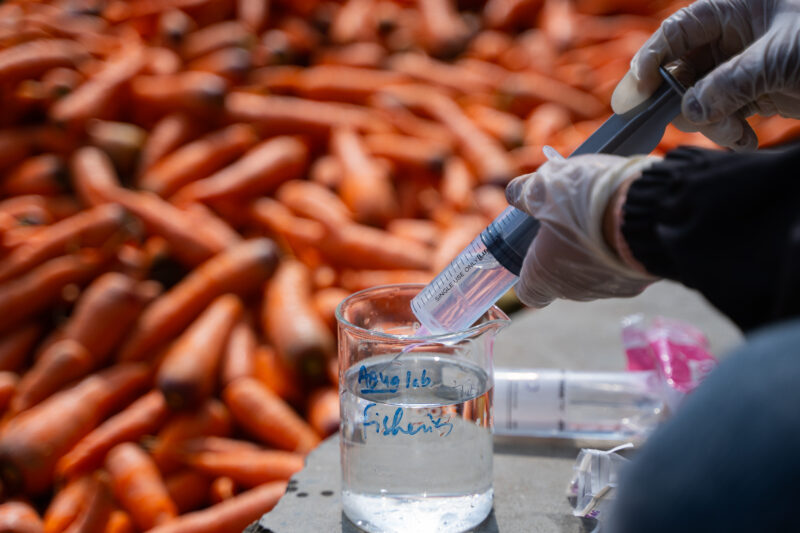
A splash of irrigation water in a field, a rinse at the market, a thorough wash of salad vegetables before a meal: all three are moments when water contaminated with foodborne pathogens can turn nutrient-rich produce into a vehicle for foodborne illness. A nationwide study of contamination in the water sources used by growers, vendors and consumers in Nepal underscores the pressing need for policies and programs to increase the safety of water used in Nepal’s food systems.
“It is important for dietary diversity and nutrition to consume fresh produce, but raw produce poses a risk of foodborne illnesses,” said lead author Aditya Khanal, associate professor in the Department of Agricultural and Environmental Sciences at Tennessee State University. “Identifying barriers to fresh produce safety, such as water quality, can inform policies and investments to reduce foodborne illness.”
The study involved a nationwide sampling effort in five metropolitan areas, as well as 10 vegetable production hubs across all seven of Nepal’s provinces. In total, 394 randomly selected water samples were collected, including 156 from consumer households and 238 from growers or vendors. The presence of Escherichia coli (E. coli) was used as an indicator of contamination risk in water.
The findings painted a stark picture: overall, 59% of the samples were contaminated with E. coli. For water sources used by growers and vendors, the contamination rates varied significantly by location. The highest levels of contamination — above 80% — were found in Surkhet, Makwanpur, Palpa and Kaski, followed by Kailali (48%) and Kathmandu (45%). The lowest contamination levels (19%-27%) were present Chitwan, Banke, Sarlahi and Morang.
Levels of contamination differed among the types of water sources used by producers. Surface water sources, such as rivers, streams and kholas (small streams with stagnant or moving water) had an E. coli presence rate of 88%. The prevalence rate of E. coli in stored water and tap water were 66% and 58%, respectively. The lowest prevalence (29%) was present in hand-pump water, which is sourced from underground aquifers.
“It seems that the growers use different water sources for washing the produce, including stagnant or moving water on the surface, tap water and underground water,” said Rabin Aryal, a team member involved in the field study and co-author of the paper from Nepal’s Agriculture and Forestry University. “Notably, the tap water is quite contaminated compared to water sourced from underground.”
Consumers were found to use a variety of water sources to wash fresh produce, with 46% using water stored in tanks or containers, 39% using tap water and 15% using other sources, including pump water, water purchased from tank suppliers and bottled drinking water. Overall, consumer water supplies had a 67% prevalence rate with no significant differences by source type.
“Our data shows that water quality is one of the important challenges for food safety in Nepal,” said Khanal. “By taking action on water quality, we have a real opportunity to contribute to preventing foodborne illnesses.”
The authors suggest five priority areas for action:
- Public and private sector investment in infrastructure to improve consumer and producer access to clean, safe water.
- The development and adoption of water testing guidelines, food safety practices and regulations to strengthen food safety.
- Increased education and outreach to enhance the awareness of growers, consumers, vendors and processors of the health risks associated with contaminated water.
- Incentivization of the adoption of safer food- and water-use practices in the food supply chains.
- Robust monitoring to enforce regulations for safer water use in food systems.
“Improving food system water quality will require cross-sectoral collaboration and coordinated efforts among government agencies, researchers, growers, vendors and consumers,” said coauthor Ram Hari Timilsina, associate professor in the Department of Agricultural Extension and Rural Sociology at Agriculture and Forestry University. “Food safety is an emerging priority in Nepal, and we hope this data can help inform the way forward.”
This research was funded by the Feed the Future Innovation Lab for Food Safety through a project to strengthen the safety of produce in Nepal. The paper, “Contaminated Water and an Indication of Risk: Examining Microbial Contamination in the Water Used by Consumers and Commercial Growers in Fresh Produce Systems in Nepal,” was published in the March 2024 issue of the Journal of Food Protection. In addition to Khanal, Timilsina and Aryal, coauthors included Bala Sharma (Agriculture and Forestry University, Nepal) and Bharat Pokharel (Tennessee State University).
Amanda Garris is a communications specialist with the Feed the Future Innovation Lab for Food Safety.

